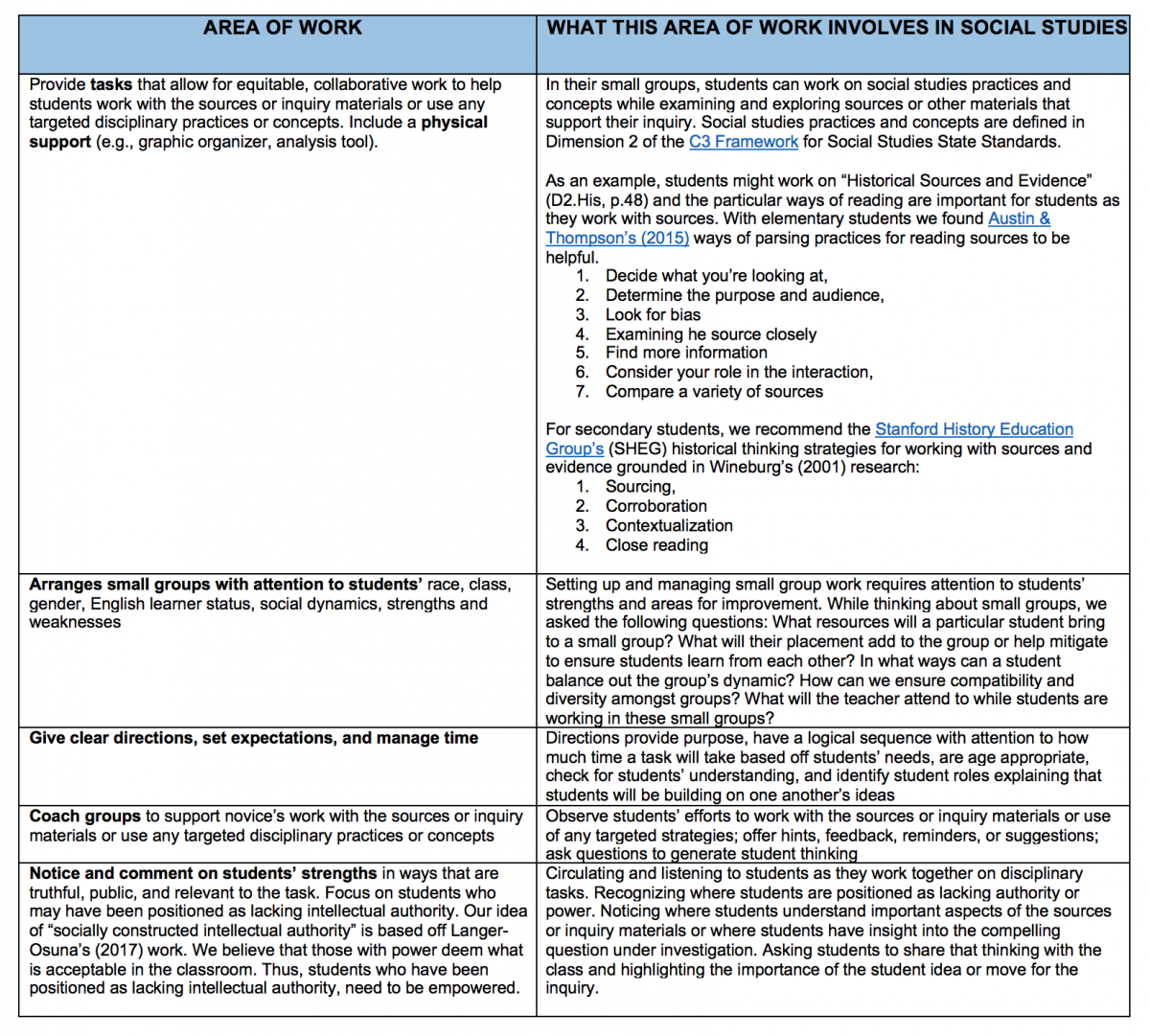Setting up and managing small group work
Small group work is an important part of social studies inquiry teaching and typically occurs in the “Experience” portion of an inquiry lesson. While working in small groups, students have the opportunity to examine sources, work together to make sense of them, listen to each other, and develop their thinking. Through small group work, students have the opportunity to talk, listen, and explore the materials of an investigation. In many ways, small group work is the core of inquiry in a classroom space. Setting up and managing small groups involves designing tasks that give students the opportunity to engage in meaningful content learning together, thinking carefully about how to form and arrange small groups, giving clear directions and expectations, coaching groups and providing other supports, and highlighting students’ strengths as they work. Forming small groups means paying close attention to who is in a small group and articulating why their presence is beneficial. It also means for the teacher, noticing students’ strengths and coaching them towards the learning goals while supporting students’ involvement in inquiry. Setting up and managing small group work involves careful orchestration and strategic decision making.
Ethical obligations, advancing justice, and small group work
Setting up and managing small group work advances justice in the classroom because it gives all students a chance to engage in conversation, problem-solve, and learn from each other. By allowing a space where students can interact with each other, small groups can provide space for students’ background knowledge and perspectives as students work together towards instructional goals. Attention to students’ background, including their social standing, race, gender, reading level, English learner status, and compatibility in a small group is essential. Attending to these characteristics means not only seeing that students are different in the classroom, but that their thoughts and ideas are valued because they are different.
Setting up and managing small group work is also essential to providing access to challenging intellectual work. Working together with one to three peers increases students’ opportunities to talk and interact around the content, to learn English and disciplinary language, to process new content, and to develop ideas. Small group work can also give students the confidence and substantive ideas to support their participation in whole-class interactions.
Setting up and managing small group work means recognizing the value of student voices and thinking and can contribute powerfully to a classroom culture where attention to student thinking is the norm. Careful planning and decision making by the teacher can begin to promote an equitable learning environment that is inclusive and responsive to all students’ needs.
Why set up and manage small group work?
In history and social science, students should be challenged in the work they are doing. This means that a task should require more effort than an independent assignment, resulting in group discussions, decision-making, and problem solving. By ensuring that students work in small groups, reading and writing goals can be accomplished, as well as social studies learning goals. For example, while analyzing a historical document, students can attend to reading strategies and discuss how these reading strategies help them draw conclusions about the document. The core work of inquiry typically happens in small groups where students can examine sources and other materials, explore compelling questions and problems with one another, discover new ideas, and develop and test their thinking. The opportunities for talk in small groups is essential to sensemaking, language learning, and engagement in inquiry.
How is small group work used in classrooms?
Small group work requires planning by the teacher before a task, during, and afterward. Small group work requires planning and reflection on which students will be in each small group and how to support groups, while attending to advancing justice in the classroom. To ensure that the task is completed thoughtfully, this means setting students up for success by providing clear expectations and directions and tasks that compel students to work together. Teachers must think about who will be in each group and how the task will be completed so that no one person is doing all the work. This also means that teachers are coaching students throughout their small group work, to support students toward the learning goals and build a productive classroom culture by highlighting strengths in students’ contributions.
We often combine small group work with modeling reading strategies during the “Experience” portion of a lesson, because together these practices give students opportunities to work with and investigate the core materials of a social studies inquiry lesson.
Decomposition of practice
The graphic below represents our thinking behind setting up and managing small group work in history/social science:

Supporting novices
Much of the work of setting up and managing small groups is invisible and when students work well together it seems almost natural. Novices need help in seeing the careful and strategic ways in which they must work to set up and manage small group work so that it works well. Novices benefit from seeing teacher educators model their thinking and rationale for forming small groups, for example. The number of formations students can be grouped into is complex work and being explicit about who is in which group and why becomes important when advancing justice in the classroom. Yet, as they work on the details of supporting small groups, novices must also keep the importance of listening to students’ thinking at the forefront. Therefore, coaching students during small group work and highlighting students’ strengths is work that novices need to practice.